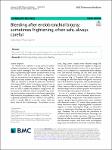Item Infomation
Full metadata record
| DC Field | Value | Language |
|---|---|---|
| dc.contributor.author | Saibin, Wang | - |
| dc.contributor.author | Qian, Ye | - |
| dc.date.accessioned | 2023-03-28T03:10:01Z | - |
| dc.date.available | 2023-03-28T03:10:01Z | - |
| dc.date.issued | 2023 | - |
| dc.identifier.uri | https://link.springer.com/article/10.1186/s12890-023-02331-9 | - |
| dc.identifier.uri | https://dlib.phenikaa-uni.edu.vn/handle/PNK/7210 | - |
| dc.description | CC BY | vi |
| dc.description.abstract | However, it should be noted that endobronchial biopsy (EBB), which is the biopsy method used in our study [2], is different from TBLB. TBLB is usually used to collect samples of peripheral lung lesions, diffuse lesions, or infiltrative lesions around the lung, meaning that the lesions commonly receive blood supply from both bronchial and pulmonary artery. In addition, TBLB is generally performed with or without X-ray guidance, and it is usually difficult to see the lesions under the direct view of the bronchoscope. Nevertheless, in our study, lung cancer samples were collected using EBB. On the one hand, the main blood supplies to lung cancer come from the bronchial arteries [3, 4], thus, the pulmonary artery pressure has anatomically little influence with EBB-induced bleeding. | vi |
| dc.language.iso | en | vi |
| dc.publisher | Springer | vi |
| dc.subject | endobronchial biopsy | vi |
| dc.subject | TBLB | vi |
| dc.title | Bleeding after endobronchial biopsy: sometimes frightening, often safe, always careful | vi |
| dc.type | Book | vi |
| Appears in Collections | ||
| OER- Y học- Điều dưỡng | ||
Files in This Item:

